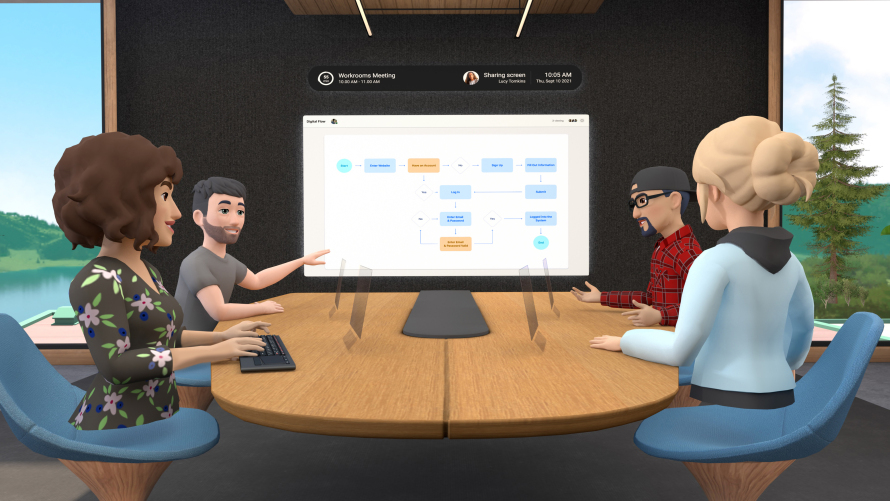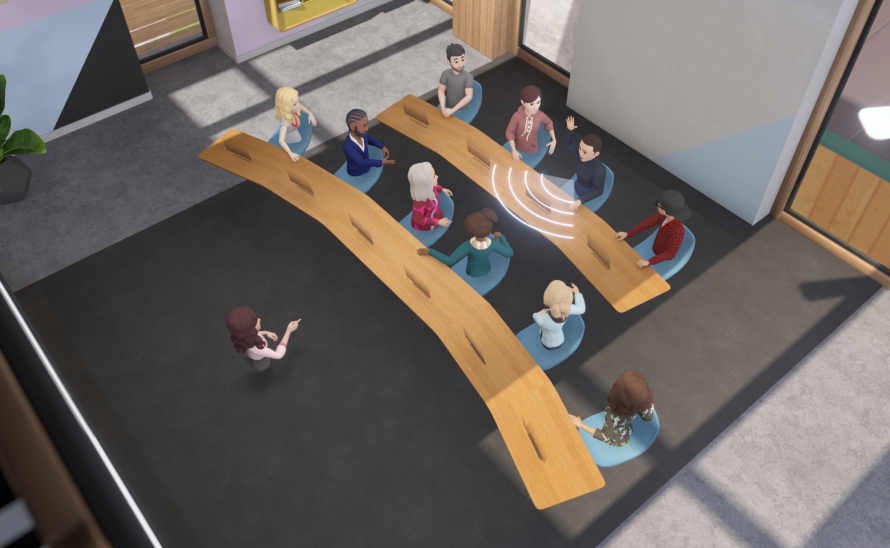In Virtual Reality and Mixed Reality News
August 20, 2021 – Facebook is continuing to grow its virtual reality (VR) for work ecosystem, as it has this week announced the launch of the open beta of ‘Horizon Workrooms’, available for free on Oculus Quest 2 in countries where Quest 2 is supported.
The company stated that Workrooms is its flagship collaboration experience that lets people come together to work in the same virtual room, regardless of physical distance. It works across both VR and the web, and is designed to improve the ability of teams to collaborate, communicate, and connect remotely, through the power of VR.
According to Facebook, Workrooms brings some of the company’s best new technologies together for the first time into one experience on Quest 2. The collaboration platform includes features like mixed-reality desks, keyboard tracking, hand tracking, remote desktop streaming, video conferencing integration, spatial audio, and the new Oculus Avatars.

Workrooms’ features include:
Mixed reality – Workrooms offers a mixed reality experience that allows users to bring their physical desk, computer, and compatible tracked keyboard into VR with them, allowing them to see items sitting on a virtual meeting table in front of them. Combined with the new Oculus Remote Desktop companion app for Mac and Windows, users will also have fast one-click access to their entire computer from VR.
Oculus Avatars and spatial audio – Using the new and improved Oculus Avatars, users have a variety of customization options and will be able to be more expressive and natural in VR through their digital avatar representations. Plus, with Workrooms’ spatial audio, users can hear people around them based on where they’re seated, just like they would sound in a real room.
Virtual whiteboard – Workrooms offers infinite whiteboard space, allowing participants to sketch things out in real time. Furthermore, a nice touch Facebook has added is that for the first time users can now flip their controllers around and use them to write with like a pen, either on the physical desk in front of them or on the whiteboard. Additionally, users can pin images from their computer on the whiteboard and then mark them up and review with colleagues. Whiteboards stick around in Workrooms for as long as they are needed too, so users can come back any time and continue working from the same room. Finally, any whiteboard can be exported out of VR and shared as an image.
Different virtual rooms – Workrooms lets users configure a virtual room’s layout to match their needs. Whether focused on collaboration, conversation, or presentation, there’s a seating layout for every occasion. Also, the whole room scales up and down to fit the size of a group.
Join in VR or by video call – For people without a VR headset, they can dial in to a room from their computer by video call and invite guests to dial in too by sharing a meeting link. Video participants will show up on a video screen in the virtual room, just like in a real conference room. Workrooms supports up to 16 people in VR together, and up to 50 people in total on a call, including video participants.
Hand tracking – Facebook said that Workrooms is one of its first experiences that was designed from the start for users to use their hands instead of controllers as the primary input. The company states that this helps to create “a more natural and expressive social experience” and also allows users to switch more easily between physical tools like keyboards and controllers when needed.
Other features in Workrooms include meeting notes, files and link sharing, chat, and calendar integration, which allows users to sync their Outlook or Google Calendar to make it easier to schedule meetings and send invites.

In terms of safety and privacy, Facebook states that Workrooms will not use work conversations and materials to inform ads on Facebook. Additionally, information from the Quest 2’s Passthrough mode, which processes images and videos of a user’s surrounding physical environment locally on the device, is not accessed by Facebook or third-party apps. Also, other users are not able to see an individual person’s computer screen in Workrooms, unless that person chooses to share it.
In addition, anyone who signs up for Workrooms must agree to follow Facebook’s ‘Community Standards and Conduct in VR Policy’. If other members or content violate these policies, users can contact their team admin who can take action such as removing someone from a Workrooms team.
Finally, using Workrooms requires a Workrooms account, which is separate from Oculus or Facebook accounts, although an Oculus username may be visible to other users in some cases. Either way, to experience Workrooms in VR, users will need to access the app on Quest 2, which requires a Facebook login. Use of Workrooms will also not make any updates to a user’s Facebook profile or timeline unless they choose it to do so.
Facebook finished by stating: “We think VR will fundamentally transform the way we work as a new computing platform, defying distance to help people collaborate better from anywhere. Horizon Workrooms is a big first step towards this vision.”
More information on Workrooms can be found on the Oculus blog, or users can simply get started at workrooms.com.
Image / video credit: Facebook
About the author
Sam is the Founder and Managing Editor of Auganix. With a background in research and report writing, he has been covering XR industry news for the past seven years.
